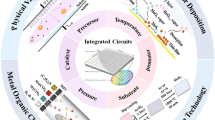Abstract
The increasing prevalence of integrated on-chip optoelectronic devices has identified serious issues regarding inter-device transmission and coupling losses, highlighting an urgent need for on-chip waveguide amplifiers to compensate for these losses. Compared with other Er-based optical materials, erbium silicate is ideally suited to high-efficiency on-chip amplifiers and lasers because of its extremely high Er3+ concentration (1022 cm−3). Nevertheless, erbium silicate must be annealed above 1000°C to crystallize and activate the Er3+, which damages other on-chip optoelectronic components and is not conducive to device integration. Here, we report a low-fabrication-temperature, high-luminescence-efficiency gain material by adding Bi2O3 to an erbium-ytterbium silicate mixed film. Our experiments demonstrate that the proposed film crystallizes at 600° C while the activation of Er3+ is also achieved, which is the lowest activation temperature of on-chip waveguide amplifier to our knowledge. This material forms the basis for a new chip-scale waveguide amplifier design, with a theoretical multi-energy-level model of Bi-Er-Yb in the mixed thin films used to analyze its signal enhancement properties. We achieve a peak on-chip gain of 23 dB in a 3.3-mm-long waveguide under the pump and signal powers of 300 mW and 1 µW, respectively. These results highlight the potential of the proposed material for realizing on-chip amplifiers and lasers for large-scale nanophotonic integrated circuits.
Similar content being viewed by others
References
Atabaki A H, Moazeni S, Pavanello F, et al. Integrating photonics with silicon nanoelectronics for the next generation of systems on a chip. Nature, 2018, 556: 349–354
Thomson D, Zilkie A, Bowers J E, et al. Roadmap on silicon photonics. J Opt, 2016, 18: 073003
Bogaerts W, Pérez D, Capmany J, et al. Programmable photonic circuits. Nature, 2020, 586: 207–216
Li N, Xin M, Su Z, et al. A silicon photonic data link with a monolithic erbium-doped laser. Sci Rep, 2020, 10: 1114
Hayat A, Tong J H, Chen C, et al. Multi-wavelength colloidal quantum dot lasers in distributed feedback cavities. Sci China Inf Sci, 2020, 63: 182401
Zimmerman D R, Spiekman L H. Amplifiers for the masses: EDFA, EDWA, and SOA amplets for metro and access applications. J Lightwave Technol, 2004, 22: 63–70
Liang D, Bowers J E. Recent progress in lasers on silicon. Nat Photon, 2010, 4: 511–517
Zhou P Q, Wang B, Wang X J, et al. Design of an on-chip electrically driven, position-adapted, fully integrated erbium-based waveguide amplifier for silicon photonics. OSA Continuum, 2021, 4: 790–814
Pu G Q, Zhang L, Hu W S, et al. Automatic mode-locking fiber lasers: progress and perspectives. Sci China Inf Sci, 2020, 63: 160404
Xi Q, Wei S H, Yuan C Z, et al. Experimental observation of coherent interaction between laser and erbium ions ensemble doped in fiber at sub 10 mk. Sci China Inf Sci, 2020, 63: 180505
Mu J, Dijkstra M, García-Blanco S M. Monolithic integration of Al2O3:Er3+ amplifiers in Si3N4 technology. In: Proceedings of European Conference on Lasers and Electro-Optics (CLEO Europe), 2019. 38
Rönn J, Zhang W W, Autere A, et al. Ultra-high on-chip optical gain in erbium-based hybrid slot waveguides. Nat Commun, 2019, 10: 432
Purnawirman, Li N, Magden E S, et al. Ultra-narrow-linewidth Al2O3:Er3+ lasers with a wavelength-insensitive waveguide design on a wafer-scale silicon nitride platform. Opt Express, 2017, 25: 13705–13713
Miritello M, Savio R L, Iacona F, et al. Efficient luminescence and energy transfer in erbium silicate thin films. Adv Mater, 2007, 19: 1582–1588
Sun H, Yin L, Liu Z, et al. Giant optical gain in a single-crystal erbium chloride silicate nanowire. Nat Photon, 2017, 11: 589–593
Mariani M, Possémé N. Front-End Processes. Nanoelectronics: Materials, Devices, Applications, 2017, 11
Colombeau B, Yeong S H, Tan D, et al. Ultra-shallow junction formation-physics and advanced technology. In: Proceedings of AIP Conference, 2008. 1066: 11
Shen Y D, Li Y W, Li W M, et al. Growth of Bi2O3 ultrathin films by atomic layer deposition. J Phys Chem C, 2012, 116: 3449–3456
Peng M, Zhang N, Wondraczek L, et al. Ultrabroad NIR luminescence and energy transfer in Bi and Er/Bi co-doped germanate glasses. Opt Express, 2011, 19: 20799
Xiao J, Cao J, Wang Y, et al. Temperature dependent energy transfer in Bi/Er codoped barium gallogermanate glasses for tunable and broadband NIR emission. J Mater Chem C, 2019, 7: 10544–10550
Dai N, Xu B, Jiang Z, et al. Effect of Yb3+ concentration on the broadband emission intensity and peak wavelength shift in Yb/Bi ions co-doped silica-based glasses. Opt Express, 2010, 18: 18642–18648
Zhou P Q, Wang X J, He Y D, et al. Effect of deposition mechanisms on the infrared photoluminescence of erbium-ytterbium silicate films under different sputtering methods. J Appl Phys, 2019, 125: 175114
Wang X J, Nakajima T, Isshiki H, et al. Fabrication and characterization of Erbium silicates on SiO2/Si substrates. Appl Phys Lett, 2009, 95: 041906
Miritello M, Savio R L, Iacona F, et al. Synthesis and luminescence properties of erbium silicate thin films. Mater Sci Eng-B, 2008, 146: 29–34
Savio R L, Miritello M, Piro A M, et al. The influence of stoichiometry on the structural stability and on the optical emission of erbium silicate thin films. Appl Phys Lett, 2008, 93: 021919
Zhou P Q, Wang S, Wang X J, et al. High-gain erbium silicate waveguide amplifier and a low-threshold, high-efficiency laser. Opt Express, 2018, 26: 16689
van den Hoven G N, Snoeks E, Polman A, et al. Photoluminescence characterization of Er-implanted Al2O3 films. Appl Phys Lett, 1993, 62: 3065–3067
Acknowledgements
This work was supported by National Natural Science Foundation of China (Grant No. 61635001).
Author information
Authors and Affiliations
Corresponding author
Rights and permissions
About this article
Cite this article
Wang, B., Zhou, P., Wang, X. et al. A low-fabrication-temperature, high-gain chip-scale waveguide amplifier. Sci. China Inf. Sci. 65, 162405 (2022). https://doi.org/10.1007/s11432-021-3360-0
Received:
Revised:
Accepted:
Published:
DOI: https://doi.org/10.1007/s11432-021-3360-0




